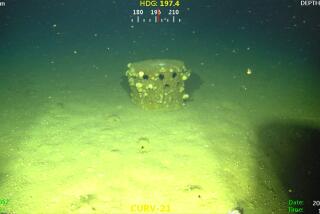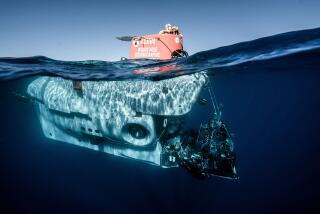Woods Hole: Answers to Deep Questions
- Share via
WOODS HOLE, Mass. — For more than a century, this tiny village at the southwest corner of Cape Cod has been a Shangri-La for the world’s marine scientists.
They come here to unlock mysteries of everything that lives in the briny deep and to use what they learn to answer fundamental questions about the human body.
Here is the oldest fisheries research facility on Earth--the National Marine Fisheries Service’s Woods Hole Station. It was established in 1871, the year it launched the 234-foot steamer Albatross, the first American ship designed and built as a research vessel.
With the knowledge that squid, sea urchins, lobster, crabs, fish and certain other marine forms have easy-to-study anatomies, scientists in 1888 founded the Marine Biological Laboratory here to use these sea animals as models for explaining human systems.
Laboratory director Harlyn Halvorson, 65, a microbiologist, says that a “good deal of what we know about our own nervous system was discovered here at the lab by studying squid.”
Sixty years ago, the Woods Hole Oceanographic Institution, a private facility originally endowed by the Rockefeller Foundation, was formed to study all branches of oceanography.
Here, too, is the U.S. Geological Survey’s marine geology branch where scientists investigate ocean resources such as oil, gas, sand, gravel, manganese and phosphorite.
And, Woods Hole is the location of the campus of the Sea Education Assn., where since 1975 undergraduates from 250 universities have come to spend a semester studying oceanography ashore and aboard research vessels that set sail from here for the oceans and seas of the world.
There are more than 50 buildings here where scientists study the sea and 13 research and collecting boats to support that effort.
Streets in the village are named after famous savants of the Seven Seas. Even the bells in the town bell tower have scientific names. One bell is called Mendel after the Austrian monk Gregor Johann Mendel, founder of the science of genetics; the other is called Louis Pasteur, after the French chemist famous for his discoveries in immunology and microbiology.
At the National Marine Fisheries Service station, 100 scientists study fish: how many there are in different parts of the ocean, how many end up in fishermen’s catches, and how fishery management affects their lives.
The large Fisheries Service aquarium, where most of the research goes on, is open without charge to the public. More than 300,000 visited the aquarium last year.
Ongoing studies at the Fisheries Service Station include research on aging among black sea bass and wrasses, whose sexual exchange patterns make them two of the most fascinating species in the sea.
“Black sea bass all hatch as females and spawn the second year of life. They get a couple of spawnings in and then by about their fourth year, they all change from female to male fish,” explained David Radosh, 44, a fishery biologist who specializes in bottom-dwelling creatures.
“Now, with the wrasses, there is a super male who has a harem of females. When the super male dies, the dominant female becomes the super male,” said Radosh.
Woods Hole Oceanographic Institution--commonly called “Who-eee” from its initials WHOI--boasts 1,000 researchers working on 400 scientific projects. WHOI’s senior scientist, Bob Ballard, discovered the wreck of the Titanic in the North Atlantic in 1985 and, before that, the wreck of the German World War II battleship Bismarck off the coast of France.
Soviet scientists recently visited here, trading places with their American counterparts now in the U.S.S.R. Together they plan to issue a report to both governments on international marine environmental policies.
A graduate degree program with the Massachusetts Institute of Technology is conducted at WHOI for about 120 students each year.
The Woods Hole Oceanographic Institution’s 210-foot research vessel, Atlantis II, left San Diego Oct. 31 on an oceanographic expedition to the Pacific. Among the 28 scientists and graduate students aboard are 12 from USC’s Marine Biology Department led by William Berelson.
Nearly every day of the year, there is a symposium on deep sea research somewhere in Woods Hole, or a lecture based on a scientific paper about to be published.
“Scientists come here from all over the world to deliver papers on their research projects, to get their work critiqued before publication,” said biologist Radosh. “Woods Hole is the one place on Earth where you will find experts on every subject pertaining to the sea.”






